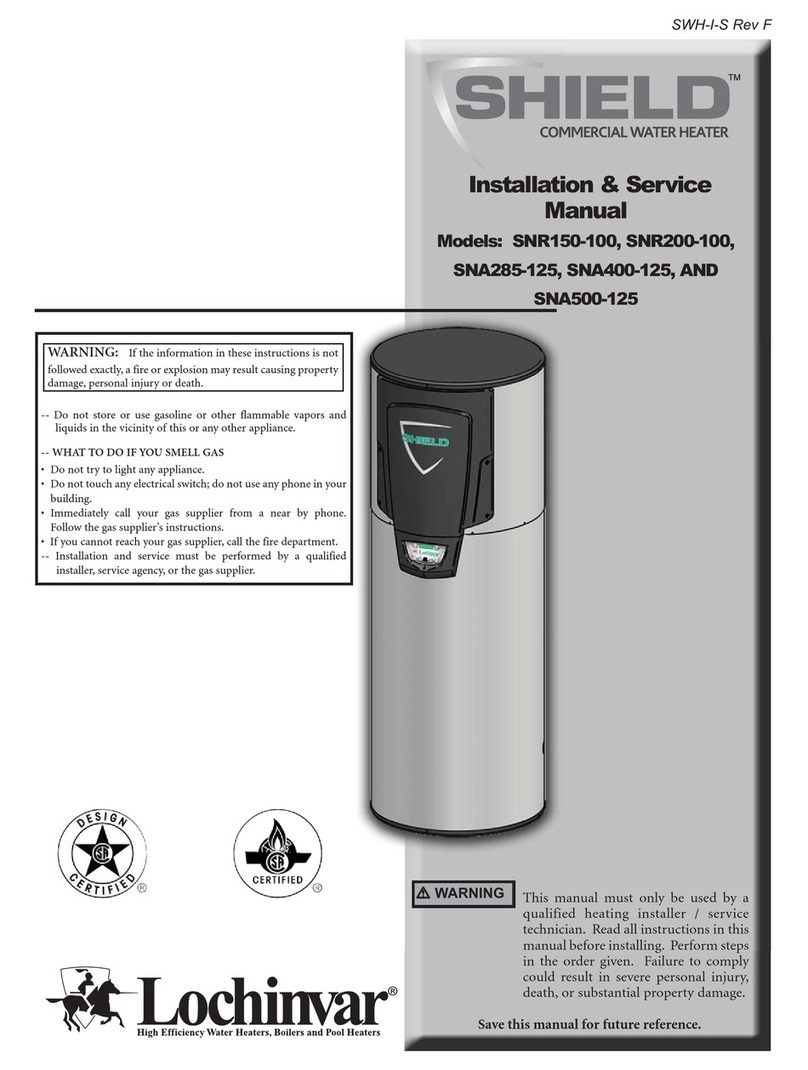
When removing a water heater from
existing common vent system:
Do not install the Shield water heater
into a common vent with any other
appliance. This will cause flue gas spillage
or appliance malfunction, resulting in
possible severe personal injury, death, or
substantial property damage.
Failure to follow all instructions can result
in flue gas spillage and carbon monoxide
emissions, causing severe personal injury
or death.
At the time of removal of an existing water heater, the
following steps shall be followed with each appliance
remaining connected to the common venting system placed
in operation, while the other appliances remaining connected
to the common venting system are not in operation.
a. Seal any unused openings in the common venting system.
b. Visually inspect the venting system for proper size and
horizontal pitch and determine there is no blockage
or restriction, leakage, corrosion, or other deficiencies,
which could cause an unsafe condition.
c. Test vent system – Insofar as is practical, close all building
doors and windows and all doors between the space
in which the appliances remaining connected to the
common venting system are located and other spaces of
the building. Turn on clothes dryers and any appliance
not connected to the common venting system. Turn on
any exhaust fans, such as range hoods and bathroom
exhausts, so they will operate at maximum speed. Do not
operate a summer exhaust fan. Close fireplace dampers.
d. Place in operation the appliance being inspected. Follow
the lighting instructions. Adjust thermostat so appliance
will operate continuously.
e. Test for spillage at the draft hood relief opening after
5 minutes of main burner operation. Use the flame of a
match or candle, or smoke from a cigarette, cigar, or pipe.
f. After it has been determined that each appliance
remaining connected to the common venting system
properly vents when tested as outlined herein, return
doors, windows, exhaust fans, fireplace dampers, and any
other gas-burning appliance to their previous conditions
of use.
g. Any improper operation of the common venting system
should be corrected so the installation conforms with the
National Fuel Gas Code, ANSI Z223.1/NFPA 54 and/or
CAN/CSA B149.1, Natural Gas and Propane Installation
Code. When resizing any portion of the common venting
system, the common venting system should be resized
to approach the minimum size as determined using the
appropriate tables in Part 11 of the National Fuel Gas
Code, ANSI Z223.1/NFPA and/or CAN/CSA B149.1,
Natural Gas and Propane Installation Code.
DANGER
WARNING
1 Determine water heater location (continued)
11
Installation & Service Manual
Failure to follow all instructions can result
in flue gas spillage and carbon monoxide
emissions, causing severe personal injury
or death.
WARNING
When using an existing vent system to
install a new water heater:
Check the following venting components before installing:
• Material - For materials listed for use with this appliance,
see Section 2 - General Venting. For polypropylene or
stainless steel venting, an adapter of the same
manufacturer must be used at the flue collar connection.
• Size - To ensure proper pipe size is in place, see Table 2A.
Check to see that this size is used throughout the vent
system.
• Manufacturer - For a stainless steel or polypropylene
application, you must use only the listed manufacturers
and their type product listed in Tables 2E and 2G for CAT
IV positive pressure venting with flue producing
condensate.
• Supports - Non-combustible supports must be in place
allowing a minimum 1/4" rise per foot. The supports
should adequately prevent sagging and vertical slippage,
by distributing the vent system weight. For additional
information, consult the vent manufacturer’s
instructions for installation.
• Terminations - Carefully review Sections 2 through 4 to
ensure requirements for the location of the vent and air
terminations are met and orientation of these fit the
appropriate image from the Sidewall or Vertical
options listed in the General Venting Section. For
stainless steel vent, only use terminations listed in Table
2H for the manufacturer of the installed vent.
• Seal - With prior requirements met, the system should be
tested to the procedure listed in parts (c) through (f) of
the Removal of an Existing Water Heater Section, this
page.
With polypropylene and stainless steel vent, seal and connect
all pipe and components as specified by the vent manufacturer
used; with PVC/CPVC vent, see the Installing Vent or Air
Piping Section on page 20.
WARNING If any of these conditions are not met,
the existing system must be updated
or replaced for that concern. Failure to
follow all instructions can result in flue gas
spillage and carbon monoxide emissions,
causing severe personal injury or death.






































